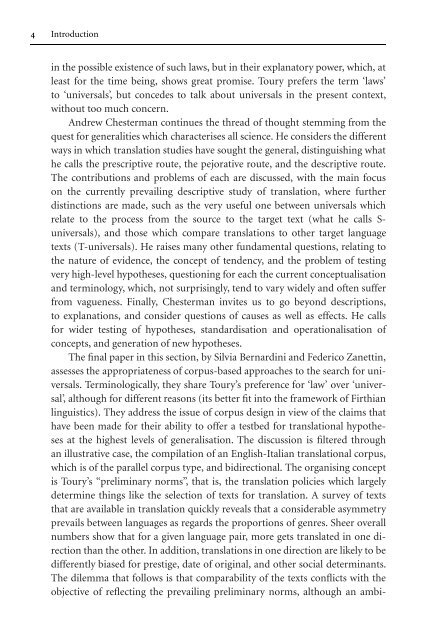Translation Universals.pdf - ymerleksi - home
Translation Universals.pdf - ymerleksi - home
Translation Universals.pdf - ymerleksi - home
You also want an ePaper? Increase the reach of your titles
YUMPU automatically turns print PDFs into web optimized ePapers that Google loves.
4 Introduction<br />
in the possible existence of such laws, but in their explanatory power, which, at<br />
least for the time being, shows great promise. Toury prefers the term ‘laws’<br />
to ‘universals’, but concedes to talk about universals in the present context,<br />
without too much concern.<br />
Andrew Chesterman continues the thread of thought stemming from the<br />
quest for generalities which characterises all science. He considers the different<br />
ways in which translation studies have sought the general, distinguishing what<br />
he calls the prescriptive route, the pejorative route, and the descriptive route.<br />
The contributions and problems of each are discussed, with the main focus<br />
on the currently prevailing descriptive study of translation, where further<br />
distinctions are made, such as the very useful one between universals which<br />
relate to the process from the source to the target text (what he calls S-<br />
universals), and those which compare translations to other target language<br />
texts (T-universals). He raises many other fundamental questions, relating to<br />
the nature of evidence, the concept of tendency, and the problem of testing<br />
very high-level hypotheses, questioning for each the current conceptualisation<br />
and terminology, which, not surprisingly, tend to vary widely and often suffer<br />
from vagueness. Finally, Chesterman invites us to go beyond descriptions,<br />
to explanations, and consider questions of causes as well as effects. He calls<br />
for wider testing of hypotheses, standardisation and operationalisation of<br />
concepts, and generation of new hypotheses.<br />
The final paper in this section, by Silvia Bernardini and Federico Zanettin,<br />
assesses the appropriateness of corpus-based approaches to the search for universals.<br />
Terminologically, they share Toury’s preference for ‘law’ over ‘universal’,<br />
although for different reasons (its better fit into the framework of Firthian<br />
linguistics). They address the issue of corpus design in view of the claims that<br />
have been made for their ability to offer a testbed for translational hypotheses<br />
at the highest levels of generalisation. The discussion is filtered through<br />
an illustrative case, the compilation of an English-Italian translational corpus,<br />
which is of the parallel corpus type, and bidirectional. The organising concept<br />
is Toury’s “preliminary norms”, that is, the translation policies which largely<br />
determine things like the selection of texts for translation. A survey of texts<br />
that are available in translation quickly reveals that a considerable asymmetry<br />
prevails between languages as regards the proportions of genres. Sheer overall<br />
numbers show that for a given language pair, more gets translated in one direction<br />
than the other. In addition, translations in one direction are likely to be<br />
differently biased for prestige, date of original, and other social determinants.<br />
The dilemma that follows is that comparability of the texts conflicts with the<br />
objective of reflecting the prevailing preliminary norms, although an ambi-
















